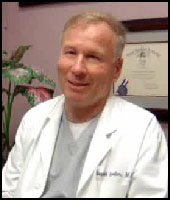
San Jose State University
Bachelors of Science – Biology
Hampton University
Masters Degree – Cell Biology
University of California – San Francisco
Doctor of Dental Surgery (D.D.S.)
University of Alabama at Birmingham School of Medicine (1995)
Medical Degree
US Army – Dental Corps
Lieutenant Colonel (retired)
Walter Reed Army Medical Center
Residency in Oral & Maxillofacial Surgery
Currently in Private Practice in Columbus Georgia
Oral & Maxillofacial Surgeon
Donald R. Moeller, a science researcher blessed with professional credentials as both physician and dentist, shoots down any possibility that unique dentition sizes and shapes result from mutations. Transiting life forms would be prime candidates for starvation while waiting for “numerous, successive, slight modifications” to evolve jawbone dentition essential to support new life! Moeller’s logic devastates Neo-Darwinism’s core dogma’s reliance on “numerous, successive, slight modifications!”
Paleontological research with respect to jaws and teeth has focused on limited aspects of the maxillo-occlusal system, specifically dental and jaw anatomy.
This narrow scope demonstrates a failure to view the fossil record using a dynamic or systems approach. Modern craniofacial and maxillofacial surgery has based its success on analysis of growth and development of a highly coordinated and interrelated group of subsystems which comprise the maxillofacial-occlusal system.
Use of the modern systems approach in analysis of the fossil record with respect to the development of chordate maxillo-occlusal apparatus to examine several subsystems exposes a lack of fossil evidence supporting gradual development of the occlusal-maxillary apparatus. Modern craniofacial/maxillafacial genetics demonstrates that pleiotrapy is present in all of the approximately one hundred genetic disorders.
Thus the simplistic idea of genetic mutations being able to cause only incremental small useful changes in the occlusion and/or jaw relationships is not supported by current research. There are no known mutations affecting single tooth morphology or single tooth enamel microstructure.
Any viable theory which attempts to explain the complex interaction and precision of the maxillofacial-occlusal complex must include genetic mechanisms, developmental processes, and fossil evidences of these processes affected by mutations and natural selection.
Current publications in orthodontics and oral and maxillofacial pathology thoroughly document that dysfunctions in all of the cranio- maxillo- occlusal systems actually do occur, and are based on known mutations and malfunctions of development. Examples include:
These developmental departures should therefore be expected in the fossil record, especially since chordate- maxillo¬occlusal relationships are so widely varied across species boundaries. An endless parade of transitional variations of all the subsystems should be evident, as well as the problematic effects caused by lack of coordination between the subsystems.
Multiple examples of malposed teeth, cysts in jaws, retained deciduous teeth, maxillary-mandibular growth and size discoordination, losses of entire classes of teeth, variation in eruption height of the various classes of teeth, tooth size arch-discrepancy variation, animal size, and tooth size coordination, should be in the fossil record.
This evidence is not seen.
The subsystem of tooth replacement presents a quandary. The reptiles have a “wave-like” replacement of every third tooth, yet all early mammals have a whole set replacement of their deciduous teeth.
There are no transitional dentitions. The earliest deciduous dentitions are fully functional.
The same quandary appears with respect to tooth attachment. There are at least eight, well-developed methods of tooth attachment in the chordates, none of which could be called primitive or advanced or could be arranged in a sequence from simple to complex. Furthermore, missing teeth due to dysfunction in periodontal attachment would evidence failure of the attachment apparatus. Transitional attachment mechanisms are not found in the fossil record.
The homeobox, which controls dental development, is specific for either the mandible or maxilla. The postulate that independent mutations can affect both arches and control the eruption height, eruption sequence, dental size, enamel microstructure, arch position, as well as individual tooth morphology while maintaining a continually functioning dentition has not been experimentally demonstrated and is statistically highly unlikely.
What the craniofacial and maxillary occlusal fossil evidences suggest is that all ten subsystems (and probably more) were fully functional in all chordates from their first appearance in the fossil record.
There is absolutely no fossil evidence of either developmental processes or pathology, which would suggest any evolutionary process leading to the development of the dentition.
There is also no known genetic or developmental process to suggest a legitimate mechanism to support an evolutionary basis for the development of the precision exhibited by the dental apparatus.
*Donald R. Moeller, DDS, MD, “Does a Smile Need 500 Million Years to Evolve?” CreationDigest.com, Spring Edition, 2002. Dr. Moeller’s credentials include Fellow, American Board of Oral and Maxillofacial Surgeons (ABOMS); and Diplomate, American Board, Oral and Maxillofacial Surgery (ACOMS).
© 2023 Warren L. Johns. All Rights Reserved.
Genesis File is an educational website.
While not a format for debate, the Editor welcomes all good faith contacts.